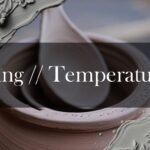When embarking on the ceramic journey, one of the most crucial steps is firing your pottery. This process transforms fragile clay into durable, lasting pieces. However, not everyone has access to their own kiln, making it necessary to seek out external firing services. Fortunately, there are several options available, each with its own set of considerations.
Exploring Options for Firing Your Pottery
One of the most accessible options is utilizing local pottery studios. These studios often offer firing services to the public, providing a convenient way to transform your creations. To find a studio near you, try searching online using terms like “pottery studio near me” or “ceramic firing services.” Websites like Yelp and Google Maps can also provide valuable leads and customer reviews. When contacting potential studios, inquire about their firing schedules, the temperature ranges they can accommodate (more on that later), and their pricing structure. Some studios charge per piece, while others base their fees on the cubic inch or weight of the pottery. Also, it’s important to remember to ask about the types of clay and glazes that they can fire, as all clays and glazes are created to mature at specific temperatures. Variance from these temperatures can lead to unsatisfactory results in ceramic durability or color. Consider whether the studio has experience firing pieces like yours, to prevent any avoidable accidents. You may even consider joining pottery co-ops.
Educational institutions, such as community colleges and universities with ceramics programs, are another avenue to explore. These institutions often have kilns available for student use and, in some cases, may extend firing services to the wider community. Contact the ceramics department of local colleges or universities to inquire about their policies and fees. Keep in mind that access to these facilities may be limited to certain times or require enrollment in a ceramics course. However, if available, this option can be more cost-effective than commercial studios, though it is still important to remember to check what types of clay and glazes can be fired.
For a more personalized approach, consider hiring independent ceramic artists who offer firing services. These artists often have their own kilns and can provide tailored firing schedules and temperature controls to suit your specific needs. Finding independent artists can be achieved through online platforms like Etsy, social media groups dedicated to pottery, or by attending local art fairs and craft shows. While this option may be more expensive than using a studio or educational institution, it offers the advantage of working with an experienced professional who can provide guidance and ensure optimal firing results. In addition, they may have more experience firing a larger variety of clay or glaze types, leading to a better and more secure final product.
Understanding Firing Temperatures and Kiln Types
Different types of clay require specific firing temperatures to achieve maturity and durability. Earthenware, a common low-fire clay often used by beginners due to its forgiving nature, typically reaches optimum hardness between 1745°F (950°C) and 2012°F (1100°C). It is typically fired between Cone 015 and Cone 1, but Cone 04 is the average. Stoneware, a mid-range or high-fire clay known for its durability and versatility, matures between 2000°F and 2400°F. It is commonly fired between Cone 2 and Cone 12, with Cone 6 and 10 being the most common for mid-range and high-fire stoneware, respectively. Porcelain, often considered the pinnacle of ceramic artistry, is a high-fire clay that produces extremely hard, shiny, and often translucent ceramics. It typically reaches maturity between 2381°F and 2455°F, and is fired between Cone 10 and Cone 13. Most types of clay are fired successfully within the temperature range of 2000°F and 2400°F, apart from porcelain, which requires higher temperatures.
Kilns are typically powered by either electricity or gas, each affecting the firing process and the final appearance of the piece. Electric kilns are more affordable and accessible, especially for home-based potters, and are great for low to mid-fire work. They are easy to load and fire, making them ideal for beginners. Gas kilns, while more expensive upfront, may cost less to run per firing due to the lower cost of propane or natural gas. They can create reduction-fired pottery with unique glazes that cannot be replicated in electric kilns. Gas kilns also allow for precise control of internal firing atmospheres and can fire to much higher temperatures. Understanding oxidation vs reduction firing helps with choosing which is right for your pieces.
There are also top-loading and front-loading kilns. Top-loading kilns are easy to use and are great for smaller projects, while front-loading kilns have a door that hinges on the front, making it easier to load substantial pieces. Front-loading kilns are more complex and expensive, but offer versatility and convenience.
Safety First: Precautions During Pottery Firing
Kilns operate at extremely high temperatures, so safety precautions are paramount. Always wear kiln mitts or gloves when handling any part of the kiln, and use dark glasses from a safety supply house to protect your eyes from radiant heat. Regular sunglasses are not sufficient and may melt when exposed to the kiln’s heat. Ensure that the kiln is properly vented to the outdoors to limit contact with toxic gases released during firing, such as carbon dioxide, sulfur dioxide, and carbon monoxide.
Maintain a safe distance of at least a foot around the kiln and remove any combustible materials from the area. Before starting the kiln, ensure that the power cord does not touch any hot parts and keep a fire extinguisher nearby. When opening a top-loading kiln, avoid standing directly in front of it and wear protective gear. Never touch a heating element during firing or insert metal instruments into the kiln while it is firing. Unplug the kiln before performing any maintenance or repairs.
Addressing Common Firing Problems
Several problems can occur during pottery firing, including cracking, warping, bloating, and glaze defects. Cracking can be caused by rapid or uneven drying, poor plasticity of the clay, or firing too fast. Warping can result from uneven drying or firing, thick and thin sections, or inadequate supports. Bloating, or bubble formation within the body, can occur due to expansion of gases trapped in a partially vitrified body. Glaze defects, such as crazing (fine cracks in the glaze surface), crawling (bare patches on the surface), and pinholes (small holes in the glaze), can be caused by a mismatch of glaze and body thermal expansions, excessive handling of dry clay ware, or development of gases from the body and/or glaze during firing. Slowing down the drying process, increasing the plasticity of the body, ensuring even drying and firing rates, and adjusting the glaze composition can help prevent these problems.
Understanding the Costs Involved
The cost of firing pottery at a studio or by a professional can vary depending on several factors, including the size and quantity of the pieces, the required firing temperature, and the studio’s pricing structure. Some studios charge per cubic inch, with prices ranging from $0.04 to $0.06 per cubic inch for both bisque and glaze firings. Others charge per pound, with prices ranging from $1.00 to $2.25 per pound depending on the type of firing and the height of the item. Some studios may offer a flat fee for a full, half, or quarter kiln. The cost of firing fees typically covers the cost of labor to load and unload the kilns, the commercial cost of electricity, and kiln maintenance.
Investing in Your Own Kiln
For potters who fire frequently, investing in a personal kiln may be a worthwhile consideration. Kilns range in price from around $1,000 for a small, top-loading electric kiln to over $15,000 for a large, front-loading gas kiln. In addition to the initial cost, consider the space requirements, electrical or gas hookups, and safety precautions necessary for operating a kiln. Electric kilns are generally easier and less expensive to install, while gas kilns may require specialized venting setups. Owning a kiln offers the convenience of firing your pottery on your own schedule and experimenting with different firing techniques. However, it also comes with the responsibility of maintaining the kiln and ensuring safe operation.
Finding a suitable place to fire your pottery involves exploring various options and considering your specific needs and resources. Whether you opt for a local studio, an educational institution, an independent artist, or investing in your own kiln, understanding firing temperatures, safety precautions, and potential problems will help you achieve successful and beautiful ceramic creations.





